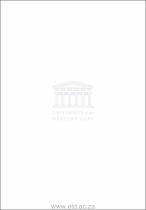| dc.description.abstract | This study was undertaken to examine the preventive dental and medical attendance behaviour of mothers of young children. The 'Theory of Reasoned Action' used to predict intention to visit the dentist and the doctor, failed to account for more than 11% of the variance in dental behaviour and 9t in the variance in medical behaviour in all the subjects. However, on assessing these behaviours for the 2 different age groups, for the younger age group, the prediction improved to 19% for the dental intention in terms of the total attitude and subjective
norm score, and to 45% and 34% respectively for the individual attitudes and subjective norms. In the older age group, the prediction improved to 20% for the dental intention in terms of the total attitude and subjective norm score, and to 39% and 30% respectively for the individual attitude and subjective norms. This finding is further supported by factor analysis of the data, whereby using a principal components analysis structure, other patterns to the data were found which indicates that preventive dental and medical behaviour is a complex behavioural category, consisting of more than one action. Two dimensionso of affect accounted for 59% of dental attitudinal data and 57.9% of the dental subjective norm data, whereas three dimensions of affect accounted for 64.5% of the medical attitudinal data and 64.8% of the medical subjective norm data. The mothers had positive attitudes to both the two dental and three medical actions highlighted by the principal components analysis. The younger mothers showed stronger attitudes associated with the treatment outcome action, whereas the older mothers showed a more positive preventive orientation by the dental data. Although two-thirds of the young mothers
received dental advice from the health visitors, they were highly selective on what information to accept and put into effect. An indication here is that health messages including dental health are perceived differently by the 2 age groups even though they are from the same social class group. This finding holds in important implications for the method, approach and content of dental heath of education. In terms of the medical data, the three actions highlighted, indicated that while a health directed behaviour, in terms of a healthy outcome e.g. normal growth is important, an expectation as well as a more emotional, love and tender care factor were also implicated. A healthy baby may however not be the only factor of importance to the mother, but also the mechanisms of achieving such a state of health, matters not only in terms of the convenience but also, greatly depend on the love and level of care the mother gives the child. This aspect may even be more accentuated in one parent families, in which especially the young mother is under enormous socia-economic pressure to take up employment, foresaking time she would otherwise have spend with the child. The effect of subjective norms on preventive health behaviour shows evidence of a 'inner cicle' or 'kinship' as reference group to the mother, which mediates between and modifies the influence of the health profession in as far as compliance with health care is expected from the mother. It therefore appears that in the lower social classes, there exists an intricate social network, exercising an important effect on the way of life of the mother, and since this network may be one of the few supports she has, its influence will be exerted in various dimensions of the mothers' life including health. There appears to be a hidden pathway or code of conduct, defined by these social norms and to which the mother feels she owes her allegiance. The level of communality between the social networks and preventive dental behaviour should be further investigated. This study has clearly indicated that some of the dental and medical attitudes and subjective norms under consideration, has a marked independent yet related effect on preventive health behaviour whereas other attitudes and subjective norms acted independently or sometimes not at all. The dental health educator, must therefore determine for each community and individual which action is the most appropiate target for behavioural change. Furthermore, this study has shown that if beliefs are to be modified, referents to support such a behaviour change, must therefore be appropiate to attaining this objective. since preventive medical and dental behaviour consists of various actions, the application of the Azjen and Fishbein model, should be to a specific action of the behaviour, which assumes importance in the target community, important others.
associated with Baric (20) has emphasised the role of the family as an important influence on attitude and behaviour, while Boothroyd- Broóks (39) has pointed to the contribution of society as important mediators in secular life. The results from this study would tend to support the views of Suchman(193), Baric(20) and Boothroyd-Brooks(39) that, kinship, family and social norms were important in the
development of behaviour but, to sustain such a behaviour, a deeper understanding is required of the social forces operative through the social network, which shapes the mothers' health behaviour into action. be this medical or dental attendance for herself or for that of her children. | en_US |

